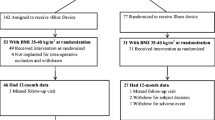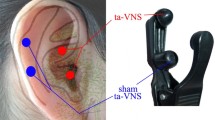Abstract
Background
One-year results of the VBLOC DM2 study found that intermittent vagal blocking (VBLOC therapy) was safe among subjects with obesity and type 2 diabetes mellitus (T2DM) and led to significant weight loss and improvements in glycemic parameters and cardiovascular risk factors. Longer-term data are needed to determine whether the results are sustained.
Methods
VBLOC DM2 is a prospective, observational study of 28 subjects with T2DM and body mass index (BMI) between 30 and 40 kg/m2 to assess mid-term safety and weight loss and improvements in glycemic parameters, and other cardiovascular risk factors with VBLOC therapy. Continuous outcome variables are reported using mixed models.
Results
At 24 months, the mean percentage of excess weight loss was 22 % (95 % CI, 15 to 28, p < 0.0001) or 7.0 % total body weight loss (95 % CI, 5.0 to 9.0, p < 0.0001). Hemoglobin A1c decreased by 0.6 percentage points (95 % CI, 0.2 to 1.0, p = 0.0026) on average from 7.8 % at baseline. Fasting plasma glucose declined by 15 mg/dL (95 % CI, 0 to 29, p = 0.0564) on average from 151 mg/dL at baseline. Among subjects who were hypertensive at baseline, systolic blood pressure declined 10 mmHg (95 % CI, 2 to 19, p = 0.02), diastolic blood pressure declined by 6 mmHg (95 % CI, 0 to 12, p = 0.0423), and mean arterial pressure declined 7 mmHg (95 % CI, 2 to 13, p = 0.014). Waist circumference was significantly reduced by 7 cm (95 % CI, 4 to 10, p < 0.0001) from a baseline of 120 cm. The most common adverse events were mild or moderate heartburn, implant site pain, and constipation.
Conclusions
Improvements in obesity and glycemic control were largely sustained after 2 years of treatment with VBLOC therapy with a well-tolerated risk profile.



Similar content being viewed by others
References
Jensen MD, Ryan DH, Apovian CM, et al. 2013 AHA/ACC/TOS guideline for the management of overweight and obesity in adults: a report of the American College of Cardiology/American Heart Association Task Force on Practice Guidelines and The Obesity Society. Circulation. 2014;129:S102–38.
Knowler WC, Barrett-Connor E, Fowler SE, et al. Reduction in the incidence of type 2 diabetes with lifestyle intervention or metformin. N Engl J Med. 2002;346:393–403.
Diabetes Prevention Program Research G, Knowler WC, Fowler SE, et al. 10-year follow-up of diabetes incidence and weight loss in the Diabetes Prevention Program Outcomes Study. Lancet. 2009;374:1677–86.
Mingrone G, Panunzi S, De Gaetano A, et al. Bariatric surgery versus conventional medical therapy for type 2 diabetes. N Engl J Med. 2012;366:1577–85.
Ikramuddin S, Blackstone RP, Brancatisano A, et al. Effect of reversible intermittent intra-abdominal vagal nerve blockade on morbid obesity: the ReCharge randomized clinical trial. JAMA. 2014;312:915–22.
Shikora S, Toouli J, Herrera MF, et al. Vagal blocking improves glycemic control and elevated blood pressure in obese subjects with type 2 diabetes mellitus. J Obes. 2013;2013:245683.
Camilleri M, Toouli J, Herrera MF, et al. Intra-abdominal vagal blocking (VBLOC therapy): clinical results with a new implantable medical device. Surgery. 2008;143:723–31.
The seventh report of the joint national committee on the prevention, detection, evaluation, and treatment of high blood pressure (JNC-7). Bethesda, National Institutes of Health (US); 2003.
Ikramuddin S, Korner J, Lee WJ, et al. Roux-en-Y gastric bypass vs intensive medical management for the control of type 2 diabetes, hypertension, and hyperlipidemia: the Diabetes Surgery Study randomized clinical trial. JAMA. 2013;309:2240–9.
Schauer PR, Kashyap SR, Wolski K, et al. Bariatric surgery versus intensive medical therapy in obese patients with diabetes. N Engl J Med. 2012;366:1567–76.
Brethauer SA, Harris JL, Kroh M, et al. Laparoscopic gastric plication for treatment of severe obesity. Surg Obes Relat Dis. 2011;7:15–22.
de Jonge C, Rensen SS, Verdam FJ, et al. Endoscopic duodenal-jejunal bypass liner rapidly improves type 2 diabetes. Obes Surg. 2013;23:1354–60.
Miras M, Serrano M, Duran C, et al. Early experience with customized, meal-triggered gastric electrical stimulation in obese patients. Obes Surg. 2015;25:174–9.
Fujioka K. Benefits of moderate weight loss in patients with type 2 diabetes. Diabetes Obes Metab. 2010;12:186–94.
Acknowledgments
We acknowledge Drs. Daniel Bessessen, James Freston, Miguel Herrera, Melissa Martinson, and Frank Moody for participation as members of the Data and Safety Monitoring Board and Clinical Events Committee. We also acknowledge Jody Dew for safety data reporting, Lisa Thackeray and Teresa Yurik for statistical analysis, and Brenda Bachmann, Jane Collins, Ruth Hutchinson, and Magnus Strommen for study coordination.
Author information
Authors and Affiliations
Corresponding author
Ethics declarations
Funding
EnteroMedics Inc. fully sponsored the VBLOC DM2 study. The study design, data collection, and data integrity are ensured by the sponsor, though data analysis was conducted by an independent contractor.
Conflict of Interest
Drs. Shikora, R. Brancatisano, and Billington have received support as consultants from EnteroMedics Inc. Drs. Tweden and Knudson are employees of EnteroMedics Inc. Drs. Herrera and Pantoja received support for proctoring from EnteroMedics Inc. Drs. Toouli, Kow, and A. Brancatisano have received support for traveling in the past from EnteroMedics Inc. Dr. Billington reports that he is a consultant for EnteroMedics and NovoNordisk and has received grant support from Covidien. Drs. Kulseng, Zulewski, and Johnsen report no conflicts of interest.
Ethical Approval
All procedures performed in studies involving human participants were in accordance with the ethical standards of the institutional and/or national research committee and with the 1964 Helsinki declaration and its later amendments or comparable ethical standards.
Electronic Supplementary Material
Below is the link to the electronic supplementary material.
ESM 1
(DOC 34 kb)
Rights and permissions
About this article
Cite this article
Shikora, S.A., Toouli, J., Herrera, M.F. et al. Intermittent Vagal Nerve Block for Improvements in Obesity, Cardiovascular Risk Factors, and Glycemic Control in Patients with Type 2 Diabetes Mellitus: 2-Year Results of the VBLOC DM2 Study. OBES SURG 26, 1021–1028 (2016). https://doi.org/10.1007/s11695-015-1914-1
Published:
Issue Date:
DOI: https://doi.org/10.1007/s11695-015-1914-1




